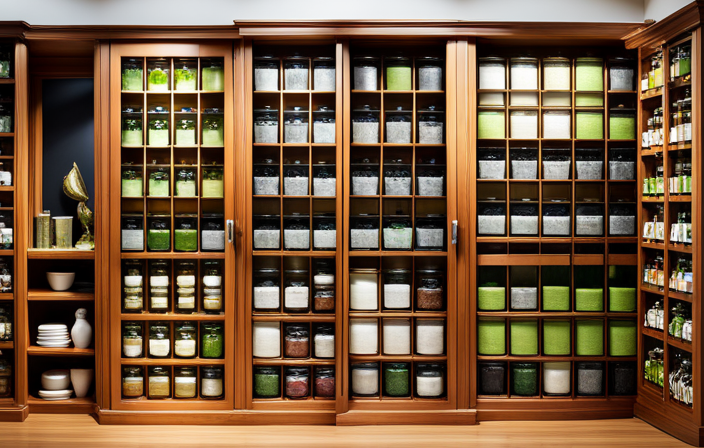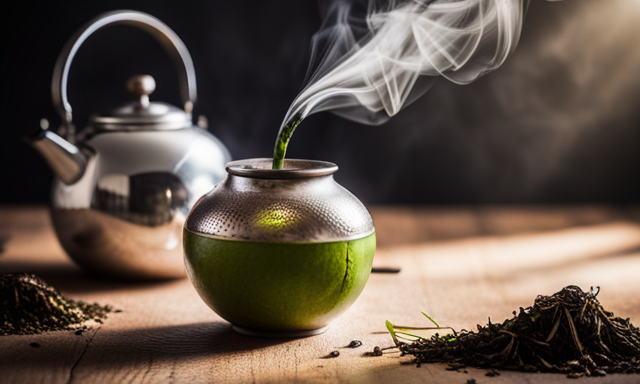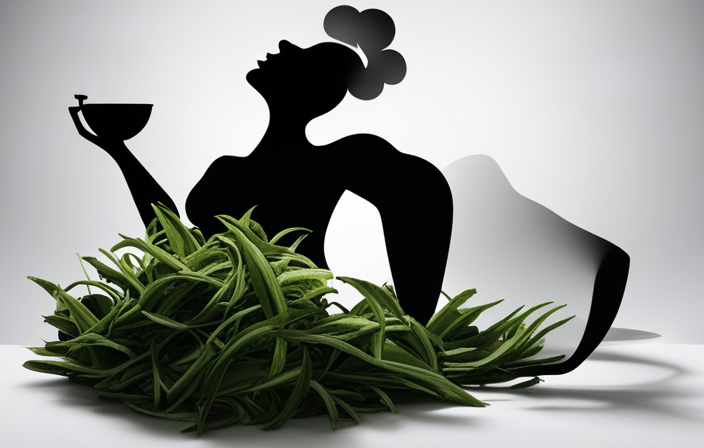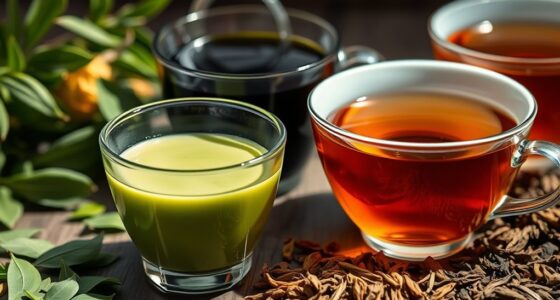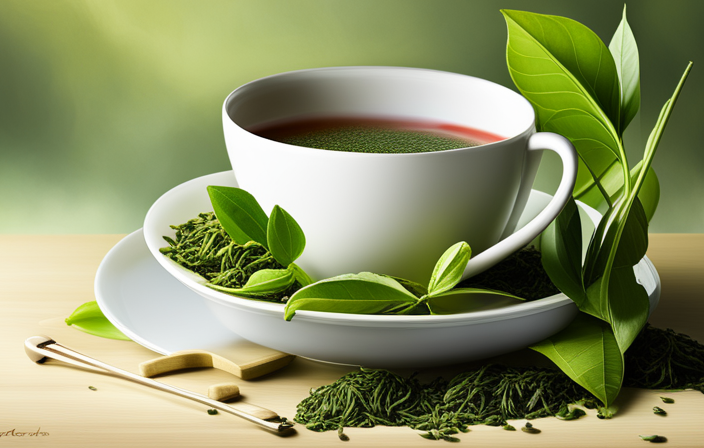As a tea enthusiast, I’ve discovered the secrets to storing green tea properly.
In this article, I’ll share with you 10 essential facts that will ensure your green tea stays fresh and flavorful.
From the right temperature and humidity levels to choosing the perfect storage container, I’ll guide you through the dos and don’ts of green tea storage.
Get ready to savor every sip of your favorite brew with these expert tips and techniques.
Let’s dive in!
Key Takeaways
- Storing green tea in a cool, dry place is crucial to maintain its quality and flavor.
- UV rays from sunlight can break down beneficial compounds in green tea, causing it to lose freshness.
- Airtight containers help minimize oxygen exposure and extend the shelf life of green tea.
- Proper UV protection, such as storing green tea in UV-blocking containers or a cool, dark place, helps preserve its integrity.
The Role of Temperature in Green Tea Storage
I’ve learned that the temperature plays a crucial role in storing green tea. To maintain its quality and flavor, it’s important to store green tea in a cool, dry place away from direct sunlight. Heat can accelerate the oxidation process and lead to the deterioration of the tea’s taste.
Ideally, green tea should be stored at a temperature between 35°F and 40°F (2°C and 4°C). It’s also essential to protect green tea from light exposure, as UV rays can break down the tea’s beneficial compounds and cause it to lose its freshness.
Additionally, oxygen can have a negative impact on green tea storage. It’s advisable to store the tea in airtight containers to minimize oxygen exposure and extend its shelf life.
Understanding the Impact of Humidity on Green Tea
Humidity can significantly affect the quality and flavor of green tea, so it’s important to understand its impact on storage and brewing.
The impact of moisture on green tea is twofold. Firstly, when exposed to high humidity, green tea leaves can absorb moisture, leading to a loss of flavor and aroma. This is because the moisture alters the chemical composition of the tea, resulting in a dull and stale taste.
Secondly, excessive moisture can create an ideal environment for mold growth. Mold not only ruins the tea leaves but also poses health risks if consumed. To prevent mold growth, it’s crucial to store green tea in a cool, dry place, away from direct sunlight and moisture.
Using airtight containers or resealable bags will help maintain the tea’s freshness and prevent any unwanted moisture from seeping in.
Choosing the Right Storage Container for Green Tea
I prefer using airtight glass containers, as they help preserve the freshness and flavor of green tea. When choosing the right storage container for green tea, it’s important to consider factors that can affect its quality, such as maintaining proper temperature and protecting it from sunlight. Airtight glass containers are ideal because they prevent air from entering, ensuring that the tea remains fresh and free from moisture. Additionally, glass containers do not absorb odors or flavors, allowing the tea to maintain its original taste. To further illustrate the benefits of using airtight glass containers, here’s a comparison table:
| Storage Container Type | Benefits |
|---|---|
| Airtight Glass Containers | Preserve freshness and flavor, prevent air and moisture from entering, do not absorb odors or flavors |
| Plastic Containers | Lightweight and portable, but may absorb odors and flavors |
| Metal Containers | Durable and long-lasting, but may affect taste and flavor |
When it comes to storing green tea, it’s not just about choosing the right container; protecting it from sunlight is equally important. Sunlight can degrade the quality of green tea and cause it to lose its beneficial properties. In the next section, we will discuss the importance of UV protection for green tea and how it can be achieved.
The Importance of UV Protection for Green Tea
UV protection is crucial for green tea due to sunlight’s detrimental effects on its quality. Exposure to UV rays can cause oxidation and degradation of the tea leaves, resulting in a loss of flavor and aroma.
To preserve the integrity of green tea, it’s essential to store it in UV-blocking containers or in a cool, dark place away from direct sunlight.
Sunlight’s Effect on Tea
Brewing my green tea in direct sunlight exposes it to harmful rays, affecting its flavor and quality. As someone who values the perfect cup of tea, I understand the importance of protecting my tea leaves from the damaging effects of sunlight.
Here are four essential facts about the effect of sunlight on tea and the importance of UV protection:
-
Oxidation: Sunlight accelerates the oxidation process in tea leaves, leading to a loss of freshness and flavor.
-
Nutrient degradation: UV rays can degrade the nutrients present in tea, such as antioxidants, reducing their health benefits.
-
Bitterness: Exposure to sunlight can increase the bitterness of tea, making it less enjoyable to drink.
-
Aroma preservation: Proper UV protection helps preserve the delicate aromas of tea, ensuring a more aromatic and flavorful brew.
Preserving Tea Quality
Storing green tea in airtight containers is essential for preserving its quality and preventing flavor degradation. By maintaining temperature control and using proper packaging, you can ensure that your green tea stays fresh and flavorful for longer periods of time. Here are some key factors to consider when storing green tea:
| Temperature Control | Proper Packaging |
|---|---|
| Keep tea away from direct sunlight and extreme temperatures. | Store tea in airtight containers to prevent exposure to air and moisture. |
| Optimal storage temperature is around 70°F (21°C) to 80°F (27°C). | Use opaque containers to block out light and maintain tea’s natural color. |
| Avoid storing tea near strong odors or spices. | Consider vacuum-sealed packaging for long-term storage. |
Uv-Blocking Storage Methods
I always make sure to shield my green tea from harmful UV rays by using opaque containers and keeping it away from direct sunlight. UV rays can degrade the quality and flavor of green tea, so it’s important to protect it.
Here are some tips on UV-blocking storage methods for green tea:
-
UV Blocking Storage Bags: Consider using specially designed UV-blocking storage bags to keep your green tea fresh and protected from harmful rays.
-
Opaque Containers: Opt for opaque containers, such as tin cans or ceramic jars, to store your green tea. These containers block out light and help preserve the tea’s freshness.
-
Glass Jars: If you prefer glass containers, choose dark-colored glass jars that can effectively block UV rays.
-
Proper Placement: Store your green tea in a cool, dry place away from direct sunlight and heat sources to further protect it.
By following these UV-blocking storage methods, you can ensure that your green tea remains fresh and flavorful for longer periods.
Now, let’s move on to the next topic: properly sealing green tea to preserve freshness.
Properly Sealing Green Tea to Preserve Freshness
To keep my green tea fresh, I always make sure to seal it properly. Proper sealing is essential for preserving the flavor and aroma of the tea. When it comes to green tea, it is crucial to protect it from exposure to air, moisture, and light. These elements can degrade the quality of the tea and lead to a loss of flavor. To help you understand the importance of sealing your green tea, here is a table highlighting the effects of improper storage on the tea’s flavor:
| Improper Storage | Effects on Tea’s Flavor |
|---|---|
| Exposed to air | Becomes stale and loses freshness |
| Exposed to moisture | Develops a musty or damp taste |
| Exposed to light | Loses its delicate flavor and color |
How to Store Loose Leaf Green Tea
I’ve found that using an airtight container is the best way to store loose leaf green tea and maintain its freshness. Here are four essential tips for storing green tea leaves:
-
Choose the right container: Opt for a container made of glass or ceramic, as these materials don’t absorb odors or affect the flavor of the tea.
-
Keep it away from light: Green tea leaves are sensitive to light and can lose their freshness when exposed to sunlight. Store them in a dark place or use an opaque container.
-
Maintain a cool and dry environment: Moisture and heat can accelerate the degradation of green tea leaves. Store them in a cool and dry place, away from the stove or any other heat source.
-
Avoid air exposure: Air can cause the tea leaves to oxidize and lose their flavor. Make sure the container is airtight to preserve the freshness of the green tea.
By following these tips, you can ensure that your loose leaf green tea stays fresh and flavorful for a longer period of time.
Now, let’s move on to the next section about storing green tea bags: tips and tricks.
Storing Green Tea Bags: Tips and Tricks
One can maximize the shelf life of green tea bags by storing them in a cool, dry place. Properly storing green tea bags not only extends their shelf life but also preserves their flavor and health benefits. Exposure to heat, light, and moisture can degrade the tea leaves and result in a loss of flavor and potency. By keeping green tea bags in a cool, dry place, you can ensure that they remain fresh and retain their beneficial properties.
When it comes to green tea bags, choosing the best brands is crucial. Look for reputable brands that use high-quality tea leaves and have a good reputation for their products.
Now, let’s delve into the ideal shelf life of green tea and how to determine if it’s still good to use.
The Ideal Shelf Life of Green Tea
I can’t believe how long green tea can stay fresh in its packaging! It’s truly amazing how shelf life can be extended with proper storage techniques. Here are some essential facts on how to store green tea right:
-
Optimal Shelf Life: Green tea can last up to 18 months if stored correctly. This allows you to enjoy its freshness and flavor for a significant period.
-
Airtight Containers: To maintain freshness, store green tea in airtight containers, away from light, heat, and moisture. This helps prevent oxidation and the loss of flavor.
-
Ideal Storage Temperature: Green tea is best stored between 35-50°F (2-10°C). Avoid extreme temperature fluctuations, as they can degrade the tea’s quality.
-
Avoid Strong Odors: Green tea easily absorbs odors, so keep it away from strong-smelling items in your pantry.
Avoiding Common Mistakes in Green Tea Storage
To ensure optimal freshness, it’s crucial to store green tea away from direct sunlight and in a cool, dry place. Proper storage is key to maintaining the delicate flavors and health benefits of this beloved beverage. Let’s discuss some common storage mistakes and the best practices for green tea storage.
| Common Storage Mistakes | Best Practices for Green Tea Storage |
|---|---|
| Exposing tea to sunlight | Store green tea in a dark, opaque container to protect it from harmful UV rays. |
| Storing near strong odors | Keep green tea away from spices, herbs, or any strong-smelling substances to prevent flavor contamination. |
| Storing in a humid environment | Moisture can degrade the quality of green tea, so store it in a cool and dry place to maintain its freshness. |
| Not sealing the container properly | Air exposure can cause oxidation, so ensure that your green tea is stored in an airtight container. |
| Storing for too long | Green tea should be consumed within 6-12 months for the best flavor. Avoid hoarding and buy in smaller quantities to maintain freshness. |
Reviving Stale Green Tea: Expert Tips and Techniques
As an expert in green tea, I’ve discovered some effective techniques for reviving stale tea.
First, try placing the tea leaves in a sealed container with a slice of citrus peel for a few hours to infuse them with fresh aromas.
Another method is to lightly toast the leaves in a pan to restore their flavor.
Stale Tea Revival Techniques
There’s a technique I’ve learned for reviving stale tea that involves adding a slice of lemon and a sprinkle of sugar. However, it’s important to note that prevention is always better than revival when it comes to tea.
Here are some essential tips for storing tea and preserving its quality:
-
Keep it airtight: Stale tea is often the result of exposure to air, which can cause it to lose its flavor and aroma. Store your tea in airtight containers to protect it from moisture and oxygen.
-
Avoid heat and light: Tea is sensitive to heat and light, which can accelerate its deterioration. Store your tea in a cool, dark place, away from direct sunlight or heat sources.
-
Separate flavors: Different teas have distinct flavors and aromas. To prevent cross-contamination and preserve each tea’s unique qualities, store them separately in labeled containers.
-
Use it within a year: Tea is best enjoyed fresh, so try to consume it within a year of purchase. After that, its quality may start to decline.
Expert Tips for Freshness
I’ve discovered that adding a pinch of baking soda and a splash of hot water is an effective way to revive stale green tea, but it’s crucial to follow expert tips for freshness to maintain its quality.
Green tea is delicate and can easily lose its flavor and aroma if not stored properly. To ensure the best taste, it’s important to store green tea in an airtight container, away from light, heat, and moisture. Expert advice suggests keeping it in a cool, dark place, such as a pantry or cupboard.
Additionally, using the tea within a year of purchase is recommended for optimal freshness.
These best practices will help you serve a delicious cup of green tea, filled with all its natural goodness.
Proper Green Tea Storage
Storing green tea properly is essential for preserving its freshness and flavor. As someone who loves tea and wants to serve others the best cup possible, I’ve gathered some helpful green tea storage tips to prevent flavor loss. Here are four key points to consider:
-
Keep it airtight: To maintain freshness, store green tea in airtight containers, such as glass jars or resealable bags. This will help prevent exposure to moisture, air, and other odors that can degrade the flavor.
-
Avoid light and heat: Green tea is sensitive to light and heat, so store it in a cool, dark place away from direct sunlight and heat sources. This will help preserve its delicate taste and aroma.
-
Minimize air exposure: Every time you open the container, air comes in contact with the tea, causing oxidation and flavor loss. To prevent this, divide your green tea into smaller portions and only open one at a time.
-
Don’t store near strong odors: Green tea easily absorbs odors from its surroundings. Keep it away from strong-smelling foods or spices to maintain its pure and natural flavor.
Frequently Asked Questions
How Long Can Green Tea Be Stored Before It Goes Bad?
I can tell if green tea has gone bad by checking for any odd smells or tastes. To store loose leaf green tea properly, I recommend keeping it in an airtight container away from heat and moisture.
Can Green Tea Be Stored in the Refrigerator?
Storing green tea in the refrigerator can affect its taste and quality. It is important to properly store loose green tea leaves to maintain freshness and flavor.
Is It Better to Store Green Tea in Airtight Bags or Containers?
It’s important to store green tea properly to maintain its freshness and flavor. When it comes to airtight bags vs. containers, I’ve found that airtight bags are better for preserving the tea’s quality.
Does the Type of Water Used to Brew Green Tea Affect Its Storage Requirements?
The type of water used to brew green tea can impact its storage requirements. Water quality can affect the taste and aroma of the tea. It’s important to use clean, filtered water for the best results. Alternative storage methods can also be considered.
Can Green Tea Be Stored Alongside Other Types of Tea Without Affecting Its Flavor?
Storing green tea with herbal tea won’t affect its flavor, but it’s best to keep them separate to preserve their individual characteristics. Avoid storing green tea in metal containers as it can alter its taste.
Conclusion
In the world of green tea storage, knowledge is key. By understanding the role of temperature, humidity, and UV protection, as well as choosing the right storage container and sealing methods, you can ensure the freshness and quality of your green tea.
Avoid common mistakes and learn how to revive stale tea with expert tips and techniques.
With these essential facts, you can savor every sip of your perfectly stored green tea like a breath of fresh air on a sunny day.

